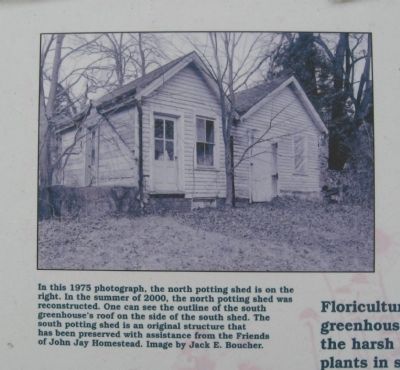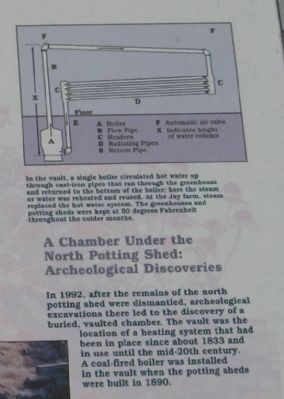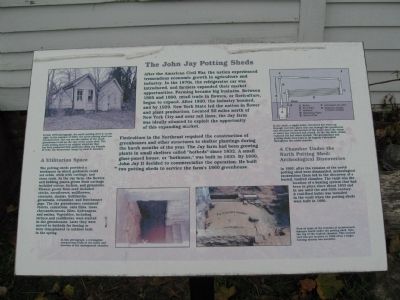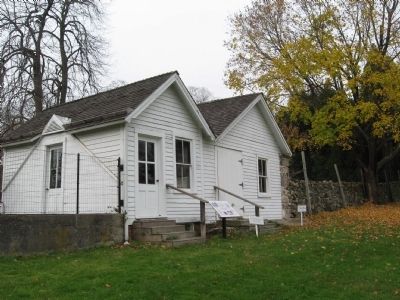Katonah in Westchester County, New York — The American Northeast (Mid-Atlantic)
The John Jay Potting Sheds
John Jay Homestead
After the American Civil War, the nation experienced tremendous economic growth in agriculture and industry. In the 1870s, the refrigerator car was introduced, and farmers expanded their market opportunities. Farming became big business. Between 1865 and 1890, retail trade in flowers, or floriculture, began to expand. After 1890, the industry boomed, and by 1929, New York State led the nation in flower and plant production. Located 50 miles north of New York City and near rail lines, the Jay farm was ideally situated to exploit the opportunity of this expanding market.
Floriculture in the Northeast required the construction of greenhouses and other structures to shelter plantings during the harsh months of the year. The Jay farm had been growing plants in small shelters called “hotbeds” since 1832. A small glass-paned house, or “hothouse,” was built in 1833. By 1890, John Jay II decided to commercialize the operation. He built two potting sheds to service the farm’s 1860 greenhouse.
Erected by Friends of the Jay Homestead.
Topics. This historical marker is listed in these topic lists: Agriculture • Notable Places. A significant historical year for this entry is 1865.
Location. 41° 15.045′ N, 73° 39.524′ W. Marker is in Katonah, New York, in Westchester County. Marker can be reached from Jay Street (New York State Route 22) 0.1 miles south of Beaver Dam Road, on the left when traveling south. Located on the grounds of the John Jay Homestead. Touch for map. Marker is at or near this postal address: 400 Route 22, Katonah NY 10536, United States of America. Touch for directions.
Other nearby markers. At least 8 other markers are within walking distance of this marker. The Glasshouse Complex and Herb Garden (within shouting distance of this marker); The Homestead Farm (within shouting distance of this marker); John Jay Homestead (within shouting distance of this marker); The Brick Lot (within shouting distance of this marker); Bedford House (about 300 feet away, measured in a direct line); The Farm Manager’s Cottage (about 300 feet away); The Beech Allee (Avenue) and Stone Fences (about 400 feet away); The Stable Courtyard (about 400 feet away). Touch for a list and map of all markers in Katonah.

Photographed By Michael Herrick, November 10, 2009
3. Potting Sheds
[ detail from the marker ]
In this 1975 photograph, the north potting shed is on the right. In the summer of 2000, the north potting shed was reconstructed. One can see the outline of the south greenhouse’s roof on the side of the south shed. The north potting shed is an original structure that has been preserved with assistance from the Friends of John Jay Homestead. Image by Jack E. Boucher.
In this 1975 photograph, the north potting shed is on the right. In the summer of 2000, the north potting shed was reconstructed. One can see the outline of the south greenhouse’s roof on the side of the south shed. The north potting shed is an original structure that has been preserved with assistance from the Friends of John Jay Homestead. Image by Jack E. Boucher.

Photographed By Michael Herrick, November 10, 2009
4. A Chamber Under the North Potting Shed: Archeological Discoveries
[ detail from the marker ]
1n 1992, after the remains of the north potting shed were dismantled, archeological excavations there led to the discovery of a buried vaulted chamber. The vault was the location of a heating system that had been in place since about 1833 and in use until the mid-20th century. A coal-fired boiler was installed in the vault when the potting sheds were built in 1890.
In the vault, a single boiler circulated hot water up through cast-iron pipes that ran through the greenhouse and returned to the bottom of the boiler; here the steam or water was reheated and reused. At the Jay farm, steam replaced the hot water system. The greenhouses and potting sheds were kept at 50 degrees Fahrenheit throughout the colder months.
1n 1992, after the remains of the north potting shed were dismantled, archeological excavations there led to the discovery of a buried vaulted chamber. The vault was the location of a heating system that had been in place since about 1833 and in use until the mid-20th century. A coal-fired boiler was installed in the vault when the potting sheds were built in 1890.
In the vault, a single boiler circulated hot water up through cast-iron pipes that ran through the greenhouse and returned to the bottom of the boiler; here the steam or water was reheated and reused. At the Jay farm, steam replaced the hot water system. The greenhouses and potting sheds were kept at 50 degrees Fahrenheit throughout the colder months.
Credits. This page was last revised on June 16, 2016. It was originally submitted on November 21, 2009, by Michael Herrick of Southbury, Connecticut. This page has been viewed 862 times since then and 24 times this year. Photos: 1, 2, 3, 4. submitted on November 21, 2009, by Michael Herrick of Southbury, Connecticut. • Syd Whittle was the editor who published this page.

